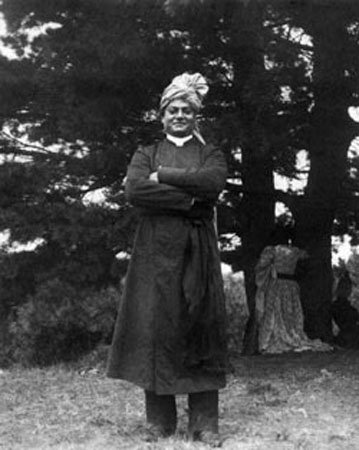Our Inspiration - The Holy Trio
Contributed by Amrita M. Salm, Ph.D. and Prem Reid
Essential qualities associated with spiritual practice in all religious traditions are wisdom (or knowledge) and compassion. These qualities are fully seen in the lives of Sri Ramakrishna, Sri Sarada Devi, known as Holy Mother, and Swami Vivekananda.
Sri Ramakrishna is the embodiment of the wisdom aspect, while Holy Mother is the embodiment of the compassion aspect. In their play on earth, these two saintly persons, considered incarnations of God by many, demonstrated the highest manifestations of these two qualities, with wisdom teachings expressed daily by Sri Ramakrishna and selfless compassion continually exhibited in the daily life of Holy Mother. Taken together, the two of them brought into being a spiritual path that was more than just the sum of these two aspects. And at times, both of them manifested elements of both aspects. Together, they showed how to integrate wisdom and compassion into spiritual practice for those living either as monastics or householders.
Holy Mother lived for over thirty years after the passing of Sri Ramakrishna. In this time she consolidated, reinforced, and put into practice the wisdom teachings of Sri Ramakrishna and demonstrated how these teachings can be practiced in daily life. Sri Ramakrishna planted the seed, then protected and guided the young plant that was to become the Ramakrishna Order. When He left his body, Holy Mother took over, nurturing the tender plant and bringing it to fruition. Holy Mother was the Shakti (feminine power) that held Sri Ramakrishna’s disciples (lay and monastic) together when he was no longer with them physically. She created a strongly-knit family through Her love, knowledge, and compassion, which guided the foundation of the Ramakrishna Order.
The third member of the trio was the dynamic element who carried the teachings of Sri Ramakrishna and Holy Mother far from their “birthplace” in Bengal. Swami Vivekananda fully imbibed and embodied the wisdom and compassion aspects manifested by Sri Ramakrishna and Holy Mother. They were, in a sense, integrated in Swamiji. Utilizing Ramakrishna’s teachings, Vivekananda incorporated the concept of the service of God through the service of man. He was tailor-made for the task of taking the message of eternal wisdom and compassion and broadcasting them worldwide. The Western world, mainly through recent translations of some of the ancient Indian texts (in particular the Upanishads) and the subsequent development of American Transcendentalism, was in a position to receive and appreciate what Swami Vivekananda had to offer over one hundred and thirty years ago.
As a result of these ancient teachings being presented in a non-sectarian manner, the world came to understand and accept Vedanta principles and practices. Sri Ramakrishna, Holy Mother, and Swami Vivekananda each had distinct personalities, attitudes, and roles to play in creating an integrated approach to spiritual life without dogma. This permits each person to pursue a path that balances his or her attitudes and tendencies.



